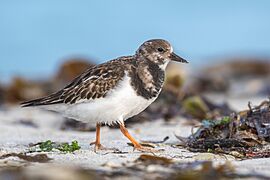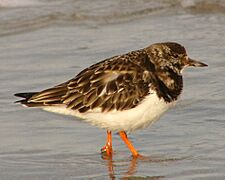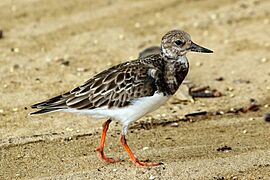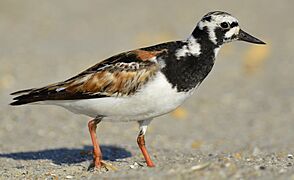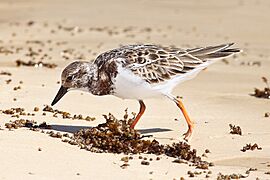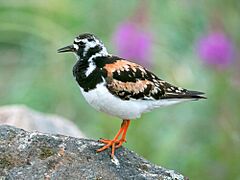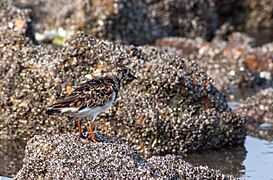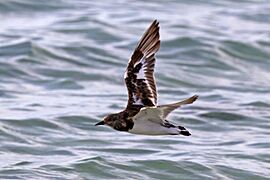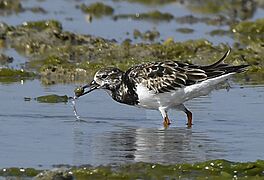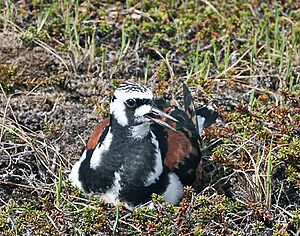Ruddy turnstone facts for kids
Quick facts for kids Ruddy turnstone |
|
|---|---|
 |
|
| Adult in breeding plumage | |
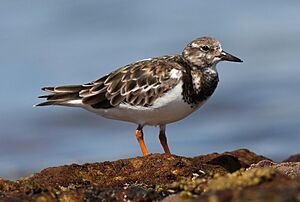 |
|
| Adult in non-breeding plumage | |
| Conservation status | |
| Scientific classification | |
| Genus: |
Arenaria (bird)
|
| Species: |
interpres
|
 |
|
| Range Breeding Non-breeding | |
| Synonyms | |
|
Tringa interpres Linnaeus, 1758 |
|
The ruddy turnstone (Arenaria interpres) is a small wading bird found almost everywhere in the world. It is one of two types of turnstone birds. Wading birds like the turnstone have long legs and usually live near water, where they walk through shallow areas to find food.
This bird belongs to the sandpiper family, called Scolopacidae. It used to be grouped with the plover family, Charadriidae. Ruddy turnstones are very good at migrating, meaning they travel long distances. They breed in northern parts of Eurasia (Europe and Asia) and North America. Then, they fly south to spend the winter on coastlines around the world. In many places, it's the only turnstone species you'll see, so people often just call it the "turnstone."
Contents
About the Ruddy Turnstone's Name
The ruddy turnstone was first officially described by a Swedish scientist named Carl Linnaeus in 1758. He gave it the scientific name Tringa interpres. Later, it was placed in the group (genus) called Arenaria.
The name Arenaria comes from a Latin word meaning "living in sand." The word interpres means "messenger." Linnaeus thought the bird's Swedish name meant "interpreter," but it actually meant "legs" in the local language, referring to another bird.
There are two main types, or subspecies, of ruddy turnstones:
- A. i. interpres: This type breeds in places like northeast Canada, Greenland, northern Europe, and parts of Siberia and Alaska. It spends winter in western and southern Europe, Africa, Asia, Australia, Pacific islands, and parts of the USA and Mexico.
- A. i. morinella: This type breeds in northeast Alaska and northern Canada. It winters in the southern USA and South America.
What Does a Ruddy Turnstone Look Like?
The ruddy turnstone is a small, sturdy bird. It is about 22 to 24 centimeters (8.7 to 9.4 inches) long. Its wingspan is about 50 to 57 centimeters (20 to 22 inches). It weighs between 85 and 150 grams (3.0 to 5.3 ounces). Its dark, wedge-shaped bill is about 2 to 2.5 centimeters (0.79 to 0.98 inches) long and points slightly upwards. Its legs are quite short, about 3.5 centimeters (1.4 inches), and are bright orange.
No matter the season, the bird's plumage (feathers) has a striking black and white pattern. When breeding, their upper parts are reddish-brown with black marks. Their head is mostly white with black streaks on top and a black pattern on their face. Their chest is mostly black with a white patch on the sides. The rest of their underside is white.
When they fly, you can see a white stripe on their wings. They also have a white patch near the base of their wing. Their lower back, rump, and tail are white, with dark bands near the tail tip. Female turnstones are a bit duller than males. They have a browner head with more streaks.
When not breeding, adult turnstones are less colorful. Their upper parts are dark grey-brown with black spots. Their head is dark with little white. Young birds have a pale brown head. Their upper body feathers have pale edges, making them look a bit scaly.
The morinella subspecies is smaller. It has darker upper parts and fewer streaks on its head.
The ruddy turnstone makes a sharp, rattling call. It also has a chattering alarm call. This alarm call is mostly heard during the breeding season.
-
On Heligoland, North Sea
-
A. i. morinella on Tobago
-
on Bald Head Island, North Carolina
-
on Floreana Island, Galapagos Islands
-
on Hailuoto Island, Finland
-
in India
-
in flight, non-breeding plumage, Madagascar
Where Do Ruddy Turnstones Live?
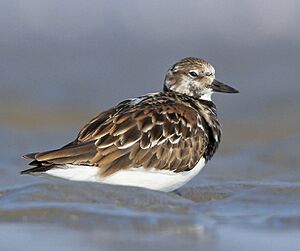
Ruddy turnstones breed in northern areas. They usually stay close to the sea, within a few kilometers. The A. i. morinella subspecies lives in northern Alaska and Arctic Canada. The A. i. interpres subspecies breeds in western Alaska, Greenland, Norway, Denmark, Sweden, Finland, Estonia, and northern Russia.
During winter, these birds travel south. In the Americas, they winter along coastlines from Washington and Massachusetts down to the southern tip of South America. In Europe, they winter in western regions, from Iceland and Norway southwards. Only a few are found on Mediterranean coasts. In Africa, they are common all the way down to South Africa. In Asia, they are widespread in the south. Some birds winter as far north as southern China and Japan. They also go south to Tasmania and New Zealand. Many non-breeding birds stay in their wintering areas all year.
Ruddy Turnstone Behavior
How Ruddy Turnstones Find Food
The ruddy turnstone eats many different things. This includes dead animals, eggs, fish, and plants. But they mainly eat invertebrates, which are animals without backbones. Insects and their larvae are very important during the breeding season. At other times, they also eat crustaceans (like crabs), spiders, molluscs (like snails), and worms.
They often flip over stones and other objects to find food hiding underneath. This is how they got their name, "turnstone"! They usually look for food in groups.
Sometimes, they have been seen eating the eggs of other birds. This includes eggs from gulls, terns, ducks, and even other turnstones. However, this behavior is not common. They usually go for nests that are not protected. They use their beaks to break the eggshells and eat what's inside.
Ruddy turnstones use different ways to find and catch their food:
- Routing: They move piles of seaweed by flicking, pushing, and pecking. This helps them find small crustaceans or snails hidden under the seaweed.
- Turning stones: As their name suggests, they use their bill to flip over stones. This uncovers hidden snails and small shrimp-like creatures.
- Digging: They make small holes in the sand or mud with their bill. Then they peck at the prey that appears, like sandhoppers or seaweed flies.
- Probing: They push their bill deep into the ground. This helps them find snails and other creatures.
- Hammer-probing: They use their bill like a hammer to crack open shells. Then they peck and probe to get the animal inside.
- Surface pecking: They use short, shallow pecks to get food that is on or just below the ground.
Studies show that turnstones might choose different feeding methods. This can depend on what they prefer, if they are male or female, or even their social standing in a group. For example, in one study, dominant birds would move seaweed. They would stop other birds from doing the same. When these dominant birds were removed, some of the other birds started moving seaweed too.
How Ruddy Turnstones Show Dominance
When looking for food, turnstones show different body positions. These positions tell other birds how dominant they are. A lowered tail and a hunched body mean they are ready to chase or be aggressive. This shows they are a dominant bird. Older birds tend to be more dominant. Younger birds are usually the ones that are less dominant.
Ruddy turnstones have many different feather patterns. This is unusual compared to other shorebirds. Turnstones use these unique patterns to recognize each other. They can tell if a bird entering their area is a stranger or a neighbor from next door. If a fake turnstone model is placed in a bird's territory, the bird is less likely to attack it if the model looks like a neighboring turnstone.
Where Ruddy Turnstones Live and Thrive
Ruddy turnstones can live in many different habitats and climates. They can be found from cold Arctic areas to warm tropical ones. Their usual breeding home is open tundra with water nearby. When they are not breeding, they live along coasts. They especially like rocky or stony shores. They are often seen on human-made structures like breakwaters and jetties. They might also go into open grassy areas near the coast. A small number sometimes appear in wetlands inland, especially when they are migrating in spring and autumn.
Ruddy turnstones are very loyal to their winter homes. A study in 2009 found that 95% of the birds that stayed in an area for winter returned to the same spot the next autumn. This study also showed that ruddy turnstones are one of the longest-living wading birds. Less than 15% of adult birds die each year. Their average lifespan is 9 years. The oldest recorded turnstone lived for 19 years and 2 months!
Ruddy Turnstone Reproduction and Life Cycle
Ruddy turnstones are monogamous, meaning one male and one female stay together. Pairs might even stay together for more than one breeding season. The nest is a shallow dip in the ground. It is often lined with leaves. The nest is about 11 centimeters (4.3 inches) across and 3 centimeters (1.2 inches) deep. They might build it among plants or on bare, stony ground. Several pairs might nest close to each other.
A female usually lays one set of two to five eggs, but four eggs are most common. The eggs are about 41 by 29 millimeters (1.6 by 1.1 inches) and weigh around 17.9 grams (0.63 ounces). They are smooth and slightly shiny. Their shape can be oval or pear-shaped. Their color varies, but they are often pale green-brown with dark brown marks. These marks are usually densest at the wider end of the egg. Incubation (keeping the eggs warm) starts when the first egg is laid. It lasts for about 22 to 24 days. The female mostly incubates the eggs, but the male might help towards the end.
Young birds are precocial. This means they are able to leave the nest soon after hatching. They are buff-colored on top with dark grey marks and white underneath. They can find their own food, but their parents protect them, especially the male. They learn to fly (fledge) after 19 to 21 days.
Status and Conservation
The International Union for Conservation of Nature (IUCN) says that the ruddy turnstone population is very stable right now. However, surveys by Environment Canada suggest their numbers have gone down since the 1970s. They face different threats during migration and winter. Environment Canada estimates that the Canadian population is between 100,000 and 500,000 adults. The Canadian Wildlife Service estimates the worldwide population is 449,000. About 235,000 of these breed in North America, while the rest breed in other Arctic regions.
Ruddy turnstones are very common and found in many places. Because they breed in remote areas and spread out widely for winter, they are likely to remain a common species.



